In the vast kingdom of insects, beetles stand as the most diverse group with over 400,000 described species. Among these remarkable creatures, some have evolved such extraordinary appearances that they seem to defy imagination. Nature, through millions of years of evolutionary experimentation, has produced beetles with shapes, colors, and features so bizarre they could easily be mistaken for alien life forms or fictional characters. From bizarre protrusions to elaborately decorated exoskeletons, these unusual insects challenge our perception of what a beetle “should” look like. This article explores some of the most peculiar-looking beetles that crawl, fly, and burrow across our planet, revealing the fascinating adaptations that make them both strange and perfectly suited to their ecological niches.
The Long-Necked Giraffe Weevil
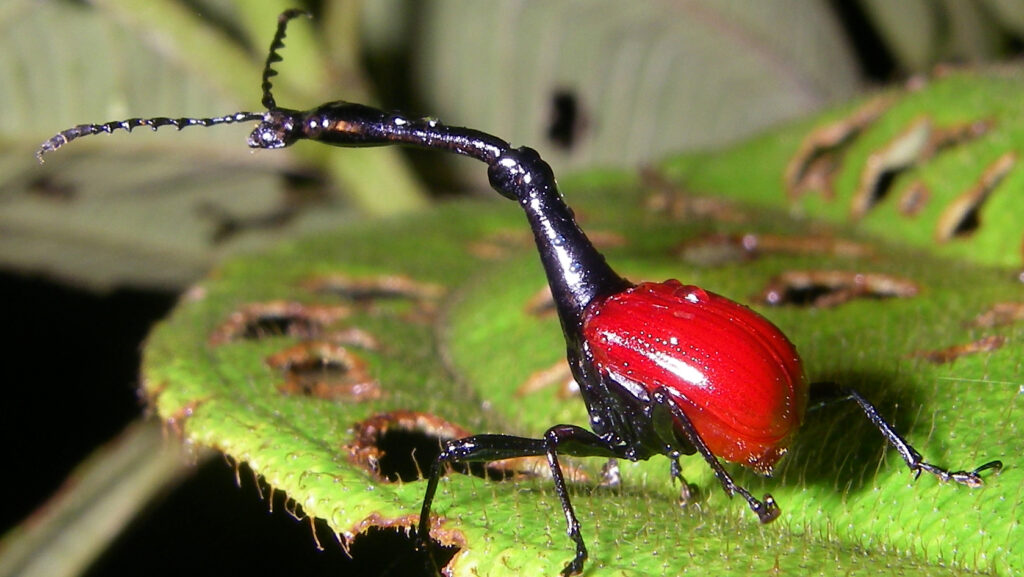
Among the strangest beetles on Earth, the Giraffe Weevil (Trachelophorus giraffa) from Madagascar immediately captures attention with its impossibly elongated neck. The males of this species possess necks that can be three times the length of their body, creating a disproportionate silhouette that seems almost comical. This extraordinary adaptation serves a very specific purpose: males use their extended necks during competitive fights for mates, wrestling with other males in fascinating displays of strength. Additionally, when the time comes for reproduction, females use their somewhat shorter necks to roll perfect leaf nests for their eggs, carefully cutting and folding leaves before depositing their precious cargo. The vibrant red elytra (wing covers) of these beetles provide striking contrast against the green foliage of their rainforest habitat, making them one of the most visually distinctive beetles despite their small size of just under an inch.
The Bizarre Cycad Weevil
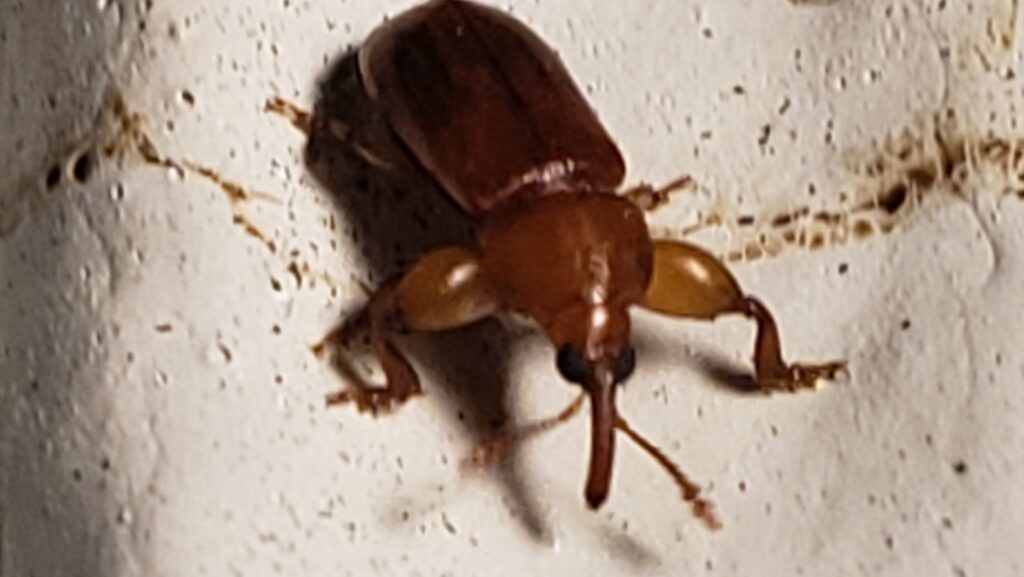
The Cycad Weevil (Rhopalotria mollis) might not immediately stand out for its body shape, but its face is truly the stuff of nightmares. This beetle sports a rostrum (snout) that resembles an alien proboscis, extending far beyond what seems practical or necessary. The rostrum is actually a specialized adaptation that allows these weevils to bore into cycad plants—ancient seed plants that have existed since the age of dinosaurs. Males possess large, curved mandibles that extend from their elongated snout, giving them an appearance reminiscent of prehistoric creatures. Fascinatingly, these beetles have co-evolved with cycads for millions of years, forming a mutualistic relationship where they serve as the primary pollinators for these ancient plants. Their bizarre appearance is therefore not just an evolutionary oddity but a perfect example of how strange adaptations can serve vital ecological functions.
The Diabolical Ironclad Beetle

The Diabolical Ironclad Beetle (Phloeodes diabolicus) might not win awards for the most outlandish appearance, but it deserves recognition for having one of the most incredibly engineered exoskeletons in the insect world. This beetle’s claim to fame is its nearly indestructible armor—so strong that it can survive being run over by a car and resist forces up to 39,000 times its body weight. The secret lies in its unusually tough, interlocking wing covers that have evolved to be virtually fused together, creating a solid shield that protects the beetle from predators. When viewed closely, the beetle’s gray and black textured exoskeleton resembles a piece of granite or iron, with strange ridges and bumps that contribute to its exceptional durability. Scientists have studied its unique exoskeletal design to inspire new impact-resistant materials for engineering applications, proving that this beetle’s weird appearance serves an extraordinary functional purpose.
The Peanut-Headed Lantern Bug

While technically not a beetle but a planthopper in the order Hemiptera, the Peanut-Headed Lantern Bug (Fulgora laternaria) is often mistakenly identified as a beetle and deserves mention for its absolutely outlandish appearance. This insect possesses what looks like an elongated peanut shell extending from its head, complete with patterns that strikingly resemble eyes. Early naturalists once believed this hollow projection could emit light (hence the name “lantern bug”), though we now know this is not the case. The false “face” created by this protrusion serves as an effective deterrent to predators, who may mistake the insect for a small reptile or other threatening creature. When the bug spreads its wings, it reveals brightly colored eyespots that further enhance this defensive mimicry. Native to rainforests of Central and South America, these insects can reach lengths of over three inches, making them as impressively sized as they are bizarrely shaped.
The Thorny Devil Stick Insect

The Thorny Devil Stick Insect (Eurycantha calcarata) represents one of nature’s most dramatic departures from the typical beetle form. Native to New Guinea, this formidable insect boasts a body covered in sharp, threatening spines that give it an almost prehistoric appearance. Males develop particularly large curved spines on their hind legs that resemble medieval weapons and are used in defensive displays against predators and competitive interactions with other males. Despite their fearsome appearance, these insects are primarily herbivores, feeding on plant material in their forest habitats. Their unusual body structure serves as excellent camouflage among branches and twigs, allowing them to blend into their environment despite their relatively large size of up to 4-5 inches. The thorny devil’s appearance is so unusual that it has become a popular species in exotic pet collections, though their specialized care requirements make them challenging to maintain outside their natural habitat.
The Violin Beetle
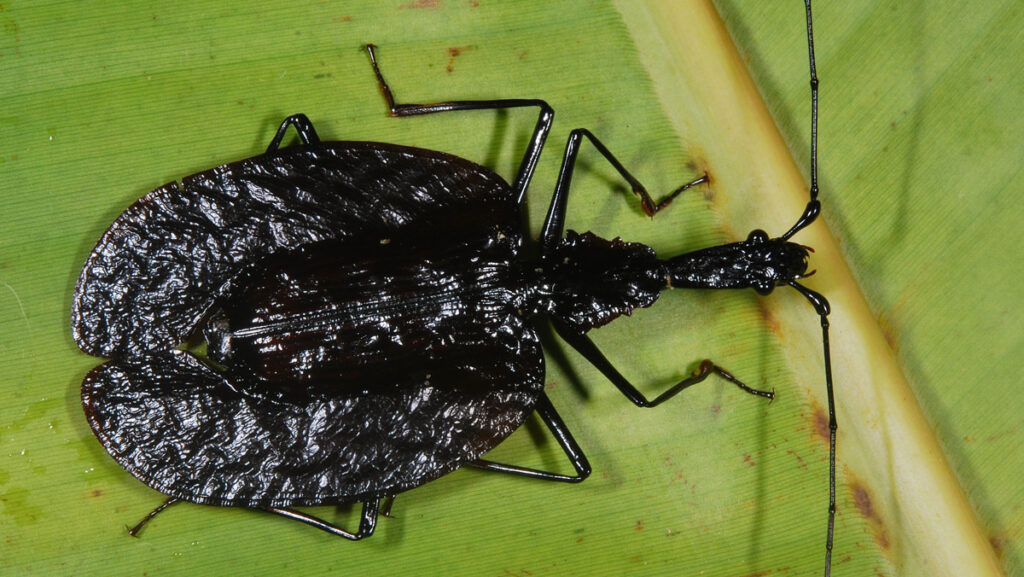
The Violin Beetle (Mormolyce phyllodes) from Southeast Asia certainly deserves a place among the weirdest-looking beetles on Earth, with a body shape that defies conventional beetle design. These remarkable insects possess extremely flattened bodies with wing covers that extend outward in leaf-like formations, creating a silhouette that resembles a violin or musical instrument. This extraordinary flattening allows them to hide in the narrowest spaces between fungal brackets or under loose bark, providing perfect concealment from predators. Growing up to three inches long, violin beetles combine their unusual shape with a glossy black-brown coloration that further enhances their cryptic nature. The larvae are equally bizarre, with flat bodies and elongated heads that allow them to navigate the tight spaces of their fungal homes. Scientists believe their odd shape evolved as a specialized adaptation to their specific ecological niche, allowing them to exploit food sources and hiding spots unavailable to beetles with more conventional body plans.
The Harlequin Beetle

The Harlequin Beetle (Acrocinus longimanus) from tropical America commands attention with its theatrical appearance that seems designed to stand out rather than blend in. These large beetles sport wing covers decorated with an intricate pattern of black, red, and gray that resembles an abstract painting or the colorful costume of their namesake theatrical character. However, their most striking feature is their front legs, which in males can grow to be twice the length of their bodies—reaching up to 6 inches in span. These extraordinarily elongated appendages serve multiple purposes: they help the beetles maintain balance on tree trunks, play a role in mating competitions, and assist in navigating their forest canopy habitats. Adding to their bizarre appearance, harlequin beetles often serve as mobile homes for pseudoscorpions and mites that hitch rides on their bodies, creating a walking ecosystem. Their distinctive coloration may serve as a warning to predators about their unpalatable taste, making this beetle not just weird-looking but also ecologically fascinating.
The Frog-Legged Leaf Beetle
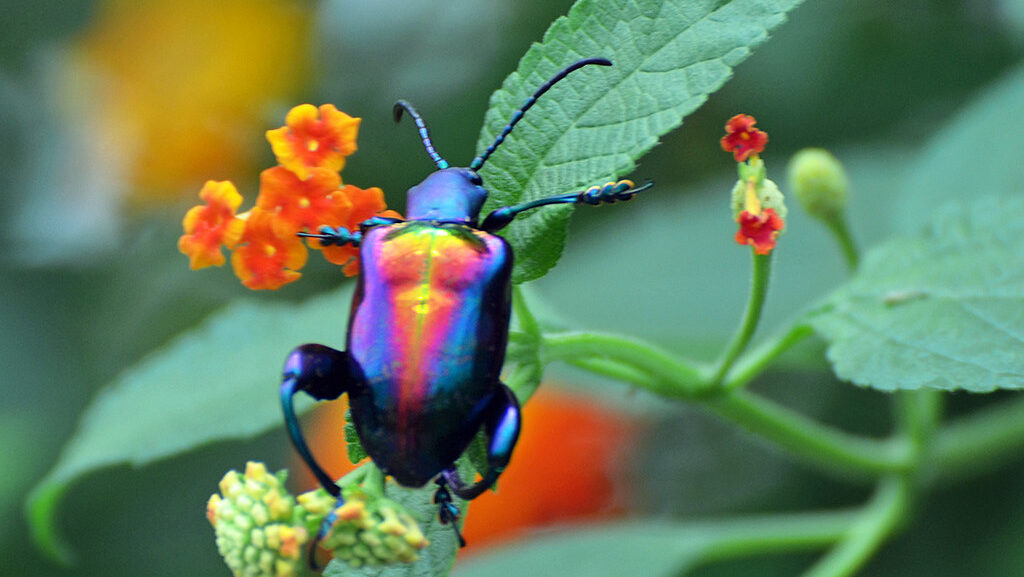
The Frog-Legged Leaf Beetle (Sagra buqueti) from Southeast Asia represents one of the most colorful and disproportionately built beetles in nature. These beetles shine with metallic purple, green, or blue iridescence that changes color depending on the viewing angle, making them resemble living jewels. The feature that earns them their name and place among the weirdest beetles is the males’ enormously enlarged hind legs that seem entirely out of proportion with their bodies. These massive, thickened legs bear sharp spines and give the beetles an appearance reminiscent of bodybuilders who have skipped upper body day at the gym. The exaggerated legs serve as weapons in male-to-male combat and help secure females during mating. Despite their fierce appearance, these beetles feed primarily on plant stems and are specialized herbivores. Their striking coloration likely serves as aposematic (warning) signaling, advertising their potential toxicity to would-be predators.
The Rhinoceros Beetle
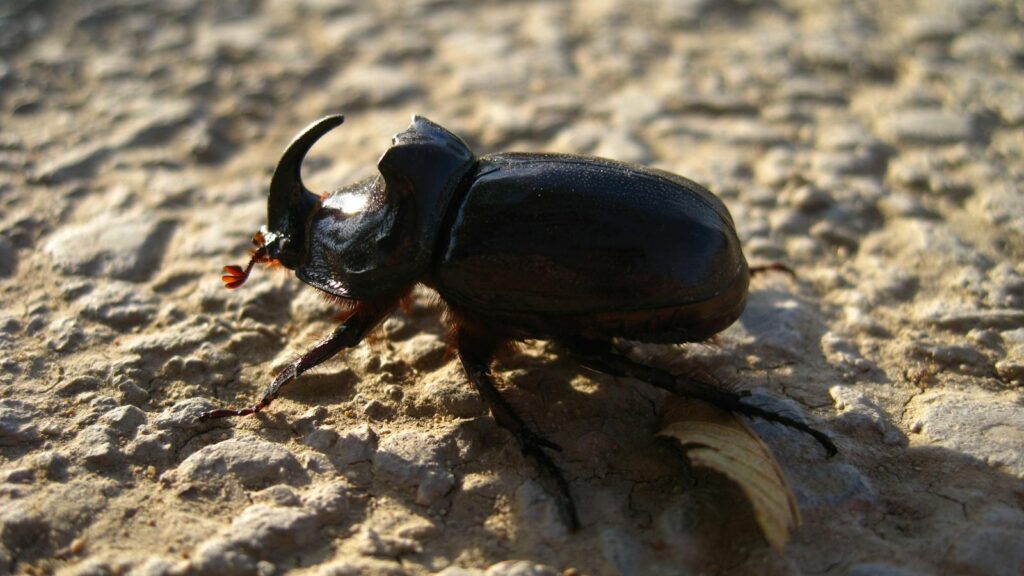
While more familiar than some entries on this list, Rhinoceros Beetles (family Dynastinae) showcase some of the most dramatic head ornaments in the insect world. Species like the Hercules Beetle (Dynastes hercules) can grow horns that exceed the length of their bodies, creating a profile that seems more mythological than natural. These formidable horns, which only appear on males, can reach lengths of up to 7 inches, making them among the proportionally largest appendages in the animal kingdom. The horns function as specialized weapons used in male combat, where rivals engage in pushing contests that resemble sumo wrestling matches to win mating opportunities. What makes these beetles particularly strange is their remarkable strength—they can carry up to 850 times their body weight, equivalent to a human lifting several elephants. Despite their intimidating appearance, rhinoceros beetles are gentle herbivores that feed on fruit, nectar, and plant sap, with their fearsome equipment reserved exclusively for battling other males.
The Eyed Elater Click Beetle
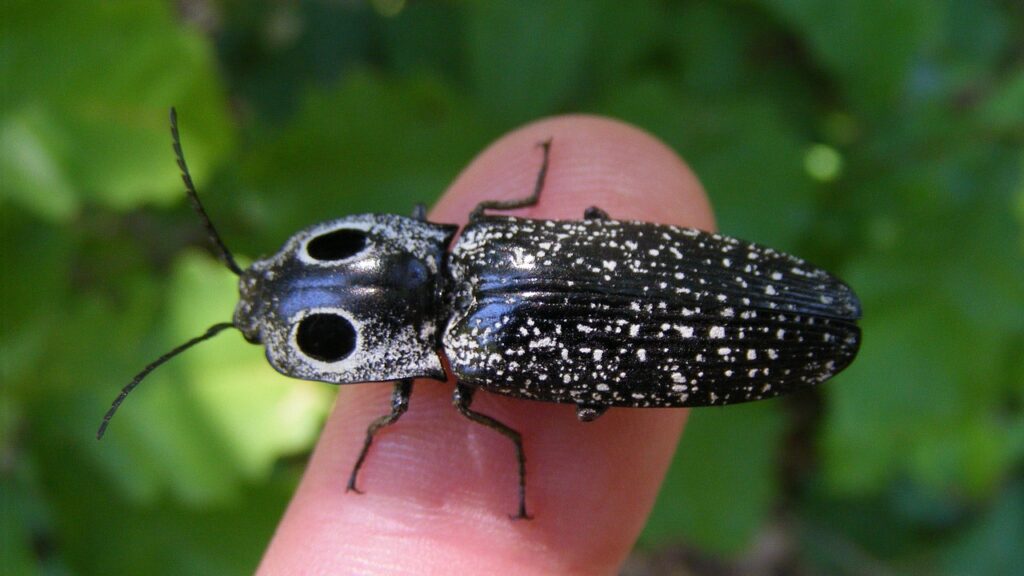
The Eyed Elater or Eastern Eyed Click Beetle (Alaus oculatus) features one of the most effective visual defenses in the beetle world, sporting two large, false “eyes” that make it look like a staring face. These eye-like markings on the beetle’s thorax are not actual eyes but rather distinctive black and white spots that can startle and confuse predators who mistake them for the face of a much larger animal. Measuring up to two inches long, this North American beetle gets its “click” name from its ability to snap a spine on its thorax into a corresponding notch, producing an audible click and launching the beetle into the air when threatened. This jumping mechanism can propel the beetle several inches upward and helps it escape predators or right itself if flipped onto its back. The combination of intimidating false eyes and acrobatic defensive jumps makes this beetle both strange-looking and remarkably well-adapted to avoiding becoming prey.
The Hammerhead Fly
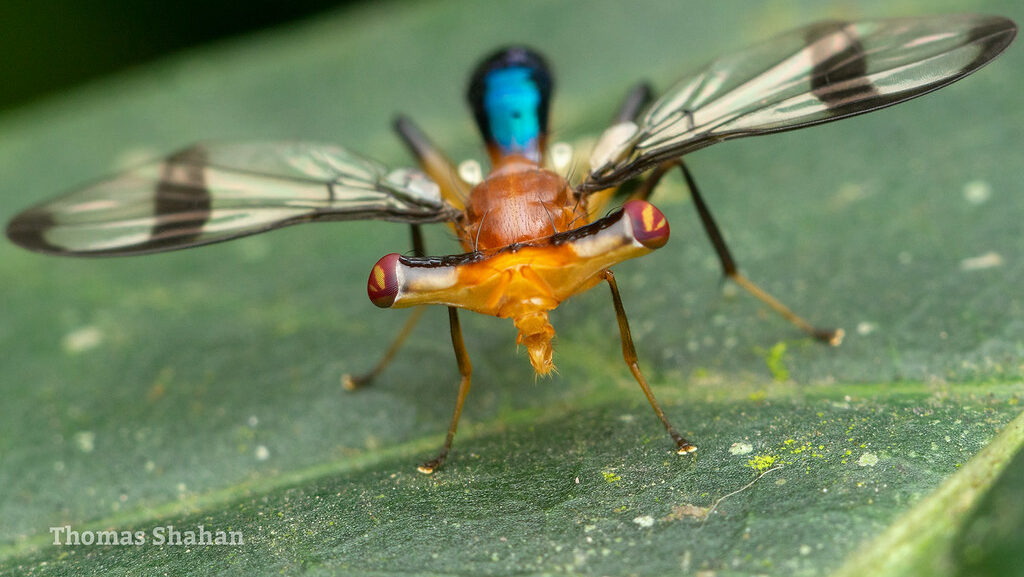
Though technically a fly rather than a beetle, the Hammerhead Fly (Sphyracephala) warrants inclusion for its absolutely bizarre head shape that often leads to misidentification. These strange insects possess heads that extend sideways into stalked eyes, creating a T-shaped appearance reminiscent of a hammerhead shark. This unique head structure provides these flies with nearly 360-degree vision, allowing them to monitor their surroundings for both predators and potential mates. Found on multiple continents including North America, these flies are relatively small but immediately recognizable due to their distinctive head shape. They typically inhabit moist environments near decaying vegetation, where their larvae develop. Their unusual appearance represents a remarkable case of parallel evolution with hammerhead sharks, where similar environmental pressures led to the development of comparable adaptations in vastly different animal groups.
The Thorn Bug

Another insect frequently mistaken for a strange beetle, the Thorn Bug (Umbonia crassicornis) possesses one of the most unusual body shapes in the insect world. These insects have evolved a large, thorn-like projection that extends upward from their bodies, creating a perfect mimicry of plant thorns. This bizarre adaptation helps them blend seamlessly with the plant stems where they feed, making them nearly invisible to predators despite their often bright green or yellow coloration. The thorn-like structure is actually an enlarged pronotum (the dorsal covering of the first thoracic segment) that has evolved to this extreme form for camouflage. These insects are actually treehoppers in the family Membracidae, related to cicadas and leafhoppers rather than beetles. They feed by piercing plant tissues and extracting sap, often gathering in large groups that can damage ornamental plants and trees. Their remarkable evolutionary adaptation demonstrates how natural selection can produce some of the strangest body forms imaginable when survival advantages exist.
The Conservation Status of Bizarre Beetles

Many of the world’s weirdest-looking beetles face serious conservation challenges as their specialized habitats disappear due to human activity. Rainforest species like the Giraffe Weevil and Violin Beetle are particularly vulnerable to deforestation in their limited ranges, with some populations becoming increasingly isolated as forest fragments shrink. Climate change represents another significant threat, as many bizarre beetle species have evolved precisely calibrated relationships with specific host plants that may shift their ranges or disappear entirely as temperatures and rainfall patterns change. The specialized nature that makes these beetles so unusual often also makes them less adaptable to rapid environmental changes. Conservation efforts focusing on habitat preservation, particularly in biodiversity hotspots like Madagascar and Southeast Asian rainforests, are essential for ensuring the survival of these evolutionary marvels. Entomologists continue working to document these species’ life cycles and ecological requirements before they potentially disappear, adding urgency to both research and conservation initiatives.
